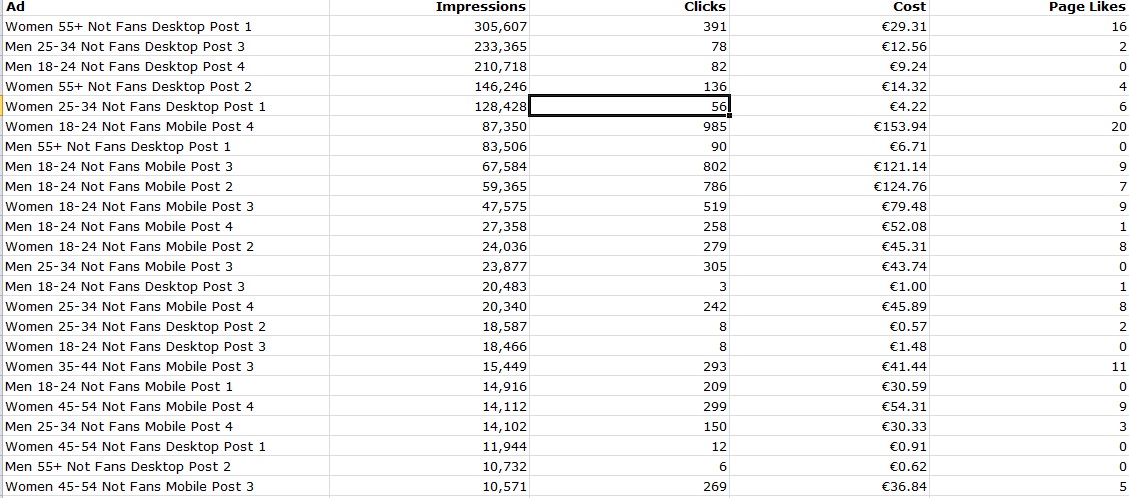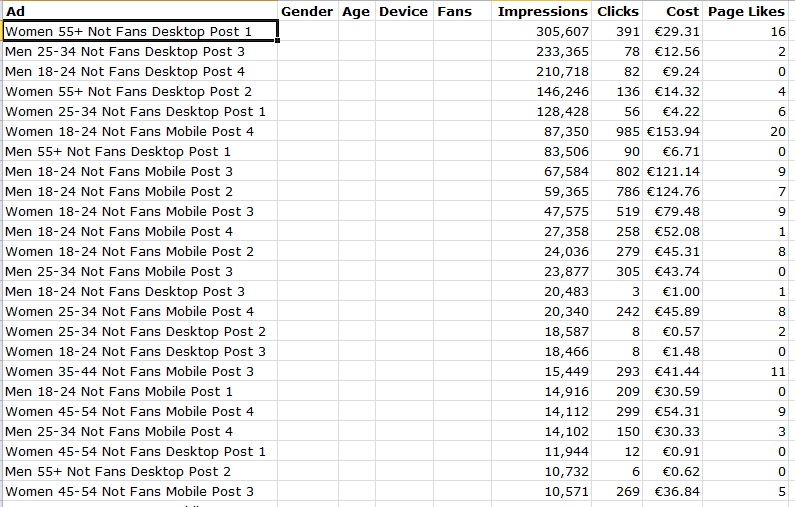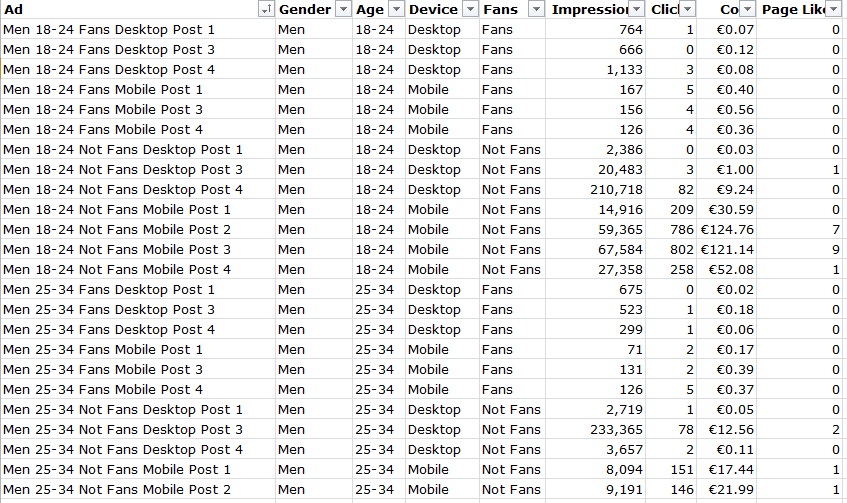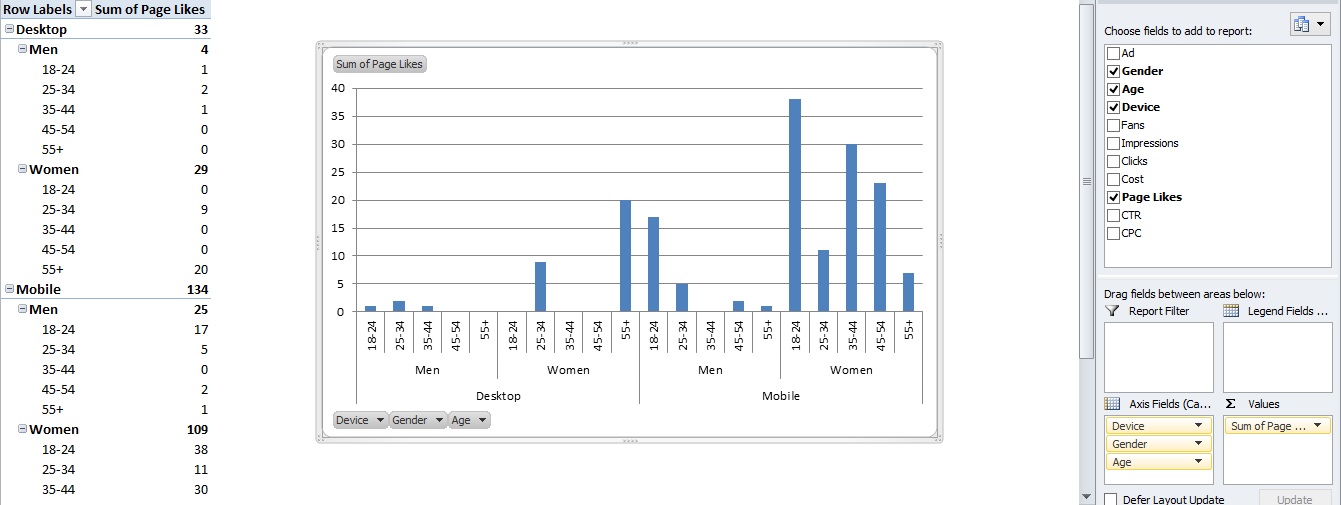Data Puke
Bounce Rate Puke
Avinash Kaushik is nuts.

Data Puke
Bounce Rate Puke
Avinash Kaushik is nuts.

The advanced targeting options in Facebook can offer a wealth of insight into your campaign’s target audience when analysing a campaign.
The real benefit of Facebook targeting is that members create profiles containing their age & sex so targeting is relatively accurate. As it’s a logged-in environment, these demographics can be served targeted ads/messaging with some accuracy every time someone logs into Facebook.
So we know that Facebook members can be segmented and targeted demographically, but ad serving is only the beginning of how this data can be used.
To get additional insight into your audience, it’s possible to analyse Facebook engagement data to show your most active segments. It is also very easy to present this in a meaningful & simple way using Excel pivot tables.
The first thing to consider with a general targeted campaign is that ads targets should be split by gender, then by age, then by device and finally by whether they are fans or not fans of your brand on Facebook already. Going on traditional gender/age demographic spits we should have 10 targets to begin, ie. men & women aged 18-24, 25-34, 35-44, 45-54, 55+.
At this point, we can add a device split by separating mobile & desktop devices. This is very important given that Facebook is accessed on mobile devices more than desktops, as a result targets will behave differently. Moreover this can have an impact on conversion, ie. if mobile is driving most traffic, a mobile-optimised website/conversion process will be key to driving success and revenue/leads. Another possible split (though not essential as it is more to do with ad formats than audience targeting) would be to target desktop right-hand column ads and newsfeed ads differently – this is not an issue for mobile as mobile only supports newsfeed ads.
Following this segmentation, targeting Facebook fans & non-fans allows us to see if the existing fanbase was more or less receptive to the messaging than non-fans.
Each ad should be named after the targeting type for easy analysis on completion of the campaign, eg. “Men 18-24 Fans Mobile – Post 1” or “Women 35-44 Not Fans Desktop Post 9” etc.

 Using filters in Excel (CTRL+L) you can populate these extra columns with the appropriate data.
Using filters in Excel (CTRL+L) you can populate these extra columns with the appropriate data.

As pivot charts aggregate all of the data into categories, it is possible to see whether men or women liked your page, on what device and what their ages are.
It is also a good idea to pull different combinations of the targeting into the axis fields and change the metrics in the values fields to see if anything strange or interesting emerges.
Facebook offers excellent insight into audience engagement with brands on social media when data is aggregated using pivot tables.
By default, target your Facebook campaigns by age, device, gender and fans/non-fans. Name your ads after the targeting type. The real benefit of this set up is that you can analyse, in aggregated detail, using Excel pivot tables, how each segment performed. This can then inform decisions about future social strategies, set KPIs and target more effectively.
Secondly, though not wholly reliable, given that the data isn’t robust enough when compared to major research houses, these report outputs provide some audience insight. The caveat is that it is only insight into the Facebook audience which isn’t representative of an entire target audience.

One of the most powerful free tools in any digital marketers inventory is hidden away in the basement of Google. Released back in 2012, I’m amazed to hear that many people still don’t use Google Tag Manager.
Google Tag Manager gives you full control of what tags you can use on a website without ever having to contact a Webmaster to get it added! Here’s the official Google Video from 2012:
So, no more calling IT to get an AdWords conversion code, Google Analytics custom line, AdRoll Pixel or any other kind of hard-coded tracking implementation. Tag Manager allows you to add any tag to a website remotely, saving time and increasing flexibility with product innovations like Dynamic Product Listing Retargeting etc.
In actual fact, there is one piece of code to implement, then you’re in the clear. When you create a Tag Manager account you have to create what’s called a container. This is where the tags live. This container has an iframe tracking pixel which is pasted just after the opening <body> tag on every page of your website. There is no need to modify this iframe code just paste it on the site and it’s plain sailing to glorious tag-free shores.
Next thing is to set up the tags in the container. The interface is quite simple but there are a few unusual steps to take.
This is the tag manager pixel from my website. You may notice I don’t have a Google Analytics in the source code. You may have even thought, this guy doesn’t even use Analytics, what the hell does he know? Well, by using Tag Manager I’ve been tracking you just like everyone else who visits. This could be a good time to revert you to my cookie policy.
There are a number pre-defined tag options in Google Tag Manager including: AdWords Conversion Tracking, AdWords Remarketing, DoubleClick Floodlight Counter, DoubleClick Floodlight Sales, Google Analytics, Classic Analytics, Custom HTML Tags (very useful), Custom Image Tags, Event Listener, Display Ad Tracking, Other Remarketing Tags, Search Tags, Audience Tags and Other Analytics Tags. Many of these can be adapted and used in a more powerful way than their hard-coded variations.
Within the campaign tracking there are a number of override tag options which can help your campaigns with last click attribution. You can also increase the sample rate of your analytics data collection and site speed measurement.
Sample rates are very useful, as you’ll notice how site speed is usually calculated using a small % of overall website visitors. This isn’t ideal as the data isn’t robust enough to really drive any insight. Tag Manager goes some way to address this without having to hard-code this line: _gaq.push([‘_setSiteSpeedSampleRate’, 100]); You can simply increase the sample rate in the Tag Manager Analytics set up in the Advanced Configuration options.
This is the trouble, Webmasters are busy doing Webmaster things, they don’t really care about AdWords tracking codes or AdRoll pixels when their server is on fire. However there is a way.
Google will be pushing for a move towards Universal Analytics in the future. Though a date hasn’t been announced, this will most certainly happen once the remarketing functionality of Classic Analytics is available in Universal Analytics. What then? Google will push for Analytics migration. You can currently see this in the tracking code section of your Analytics properties.
So in order to test how Universal Analytics will run on your website before forced-migration, we must test the Universal Analytics code on the website. Enter Tag Manager.
Websites will behave differently using Universal Analytics. You must ensure that eCommerce tracking is working correctly amongst other things. Use Tag Manager to implement this migration test. Then you’ll never have to talk to the Webmaster again about codes. Well maybe to remove hard-coded legacy tags as you populate your Tag Manager container with these.
Google Tag Manager will change how quickly you control your campaign conversions and remarketing activities. It allows for enhanced tracking in Analytics and macros can pull additional data into what’s being tracked by the tags (macros need their own post to do them justice). Testing Universal Analytics migration is the best way to encourage your Webmasters to install Tag Manager. Once Tag Manager is installed you can remove legacy codes and then you’re free.